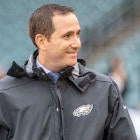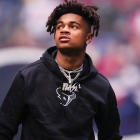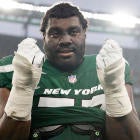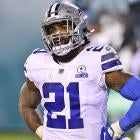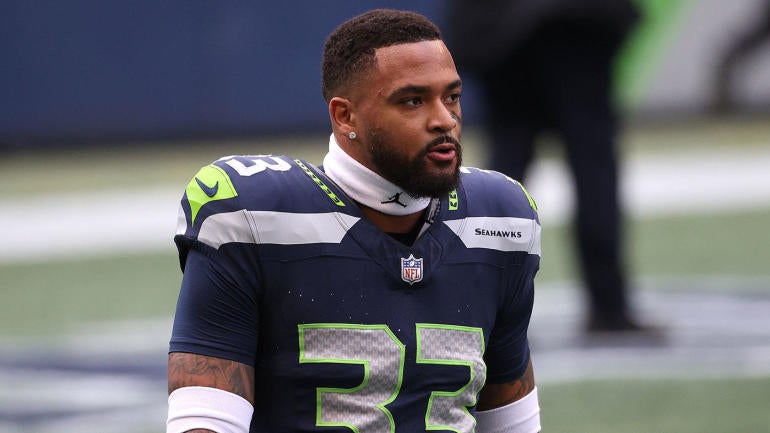
Quickly signing safety Jamal Adams to a contract extension was presumed to be a top offseason priority for the Seahawks after the Rams eliminated them in the wild-card round of the playoffs last season. The 2021 NFL Draft wasn't going to be as much of a focal point of the early part of the offseason as in previous years; Seattle only had selections in the second, fourth and sixth rounds because of multiple trades. Seattle's 2021 and 2022 first-round picks, a 2021 third-round pick and safety Bradley McDougald were dealt to the Jets last July to acquire Adams and a 2022 fourth-round pick.
Nonetheless, it's been a busy offseason for the Seahawks. Other core players heading into a contract year have all signed long-term deals. Most notably, wide receiver Tyler Lockett received a four-year, $69.2 million extension in early April. The deal has $37 million in guarantees, of which $21 million was fully guaranteed at signing. Pro Bowl punter Michael Dickson just signed a four-year, $14,699,059 extension with $8.5 million in guarantees.
General manager John Schneider reiterated in late April on the day before the draft that Adams was in Seattle's long-term plans. He characterized the draft as a celebration of Adams since this year's first-round pick was part of the draft compensation used to obtain him. Adams is scheduled to play the 2021 season under his $9.86 million fifth-year option.
The two most plausible explanations for the delay in signing Adams to a long-term deal are his contract demands and issues with Seattle's preferred contract structure.
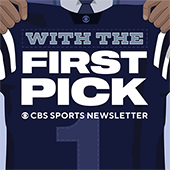
With The First Pick Newsletter
With The First Pick Newsletter
Prepare for the upcoming NFL Draft with the day’s big stories + mock drafts, big board updates and more.
Thanks for signing up!
Keep an eye on your inbox.
Sorry!
There was an error processing your subscription.
Jamal Adams' contract demands
There were reports of Adams having ambitious financial expectations prior to the Jets trading him. According to ESPN's Jeremy Fowler, a source told him last offseason that Adams wanted to be one of the NFL's highest-paid defensive players. Around the same time, Rich Cimini, who covers the Jets for ESPN, reported that Adams wanted to be the highest-paid player on the team. That distinction was then held by inside linebacker C.J. Mosley, who signed a five-year contract averaging $17 million per year in 2019 as an unrestricted free agent.
The 2020 season probably didn't do anything to keep Adams from thinking along these lines even though he struggled at times in pass coverage. In 12 games, Adams set a single-season record for sacks by a defensive back with 9.5 -- which was tied for the 11th-most in the NFL -- and was selected to his third straight Pro Bowl.
Adams doesn't view himself as just a safety. He has used the words "playmaker" or "defensive weapon" instead to describe himself. He certainly has a point based on where he lined up on the field defensively for the Seahawks. Out of Adams' 784 defensive snaps, 94 were on the defensive line, 351 were in the box, 173 were as a slot cornerback, 17 were as a wide corner and 149 were at free safety, according to Pro Football Focus. By more traditional position groupings, the breakdown was 94 on the defensive line coming off the edge, 237 at linebacker, 263 at safety and 190 at cornerback.
Adams doesn't want to be classified as a safety for good reason. Justin Simmons is the NFL's highest-paid safety at $15.25 million per year. After being designated as a franchise player by the Broncos for a second straight year, he signed a four-year, $61 million contract with $35 million in guarantees where $32.1 million was fully guaranteed at signing.
There are 10 defensive players with contracts averaging $20 million per year or more. Nine are either edge rushers or interior defensive linemen who have demonstrated an ability to consistently pressure quarterbacks.
Rams cornerback Jalen Ramsey is the only defensive back among the ten. He signed a five-year, $100 million extension worth up to $105 million through salary escalators right before the 2020 regular season started. Ramsey established new cornerback records of $71.203 million of overall guarantees and $43.703 million fully guaranteed at signing.
Adams becoming Seattle's highest-paid defensive player is likely going to be a difficult proposition. There's probably reluctance in paying anybody on the defense more than middle linebacker Bobby Wagner. The future Hall of Famer signed a three-year, $54 million extension averaging $18 million per year at the start of training camp in 2019. Wagner's contract contains $40.25 million of guarantees where $24.5 million was fully guaranteed at signing.
Unfortunately for Adams, NFL player salaries are mostly constrained by position. Adams easily being the NFL's best pass-rushing defensive back probably isn't enough to convince the Seahawks he shouldn't be paid like a safety.
Any leverage Adams may have to be treated differently comes from his acquisition cost. The Seahawks didn't give multiple draft picks intending for him to be a short-term rental. Budda Baker, who is considered the Swiss Army knife of the Cardinals defense because of his versatility, couldn't defy positional pay constraints when he became the league's highest-paid safety last September at $14.75 million per year.
It's also something Wagner couldn't do. When he signed his extension in 2019, he was legitimately in the league's best defensive player discussion. Wagner and Rams interior defensive lineman Aaron Donald were the only players to be selected-first team All-Pro by the Associated Press in each of the previous three seasons (2016 through 2018). Both have since extended the streak to five seasons. At the time, the average yearly salary of the five highest-paid defensive players was just under $21.425 million. Wagner's $18 million-per-year deal represented a 5.88% increase over Mosley's deal.
The safety market hasn't taken a dramatic jump since 2019 free agency when a player sets the new high mark. Eddie Jackson (Bears) getting 3.58% more than Kevin Byard (Titans) in January 2020 is the biggest incremental increase in average yearly salary.
A similar increase over Simmons would put Adams in the $15.75 million-per-year neighborhood. Adams getting the Seahawks to give him an increase comparable to Wagner's would put him close to $16.25 million per year.
It might be more constructive for Adams to focus on closing the gap between cornerback and safety pay. Since the end of the 2019 regular season, the top of the cornerback market has increased nearly 33% while safeties have gone up just under 9%. Approaching the midpoint of Simmons and Ramsey's deals would mean an average yearly salary in the $17.625 million range, which is below Wagner, but would be a 14.75% increase for the top of the safety market. Regardless, Adams is probably going to need to adjust his salary expectations in order to get a deal done.
Seattle's preferred contract structure
Contract structure may be just as big of a sticking point as compensation for Adams. Most of the NFL's bigger player contracts have at least the first two years fully guaranteed at signing.
A small group of teams, such as the Bengals, Packers, Steelers and Vikings, typically don't adhere to this practice. The Packers consistently make an exception with quarterback Aaron Rodgers' contracts. The Vikings also deviated from their contract conventions during 2018 free agency to sign quarterback Kirk Cousins to the NFL's first lucrative fully guaranteed veteran contract.
Seattle prefers lucrative veteran contracts to be structured where the guaranteed money consists of base salary guarantees and a signing bonus. Base salary guarantees after the first contract year are for injury only initially at signing, but typically become fully guaranteed either on the fifth day of the waiver period in each specific year or five days after the start of the waiver period. The waiver period always begins the day after the Super Bowl.
On occasion as in Lockett's case, Seattle will structure a contract with an option bonus in the second year to pick up the final year of the deal. The second-year base salary, which becomes fully guaranteed on the fifth day of the waiver period, will be inflated to ensure the option is exercised and the payment is made. This base salary will be reduced by the amount of option bonus, which is prorated on the salary cap just like signing bonus, when the option year is picked up.
The second contract year was fully guaranteed at signing in several deals negotiated prior to 2013. The Seahawks moved away from this concept with wide receiver Percy Harvin's contract in 2013.
Quarterback Russell Wilson's current contract signed in 2019 has Seattle's preferred structure. It would be surprising for the Seahawks to do something structurally with Adams that wasn't done for Wilson, Wagner or Lockett in their most recent extensions. The Seahawks made a big accommodation for Wilson in giving him a then-NFL record $65 million signing bonus. Lockett has the next biggest Seahawks signing bonus at $19 million.
The Seahawks should gain salary cap space from a new Adams deal. The largest signing bonus for a safety in recent years has been the $20 million Earl Thomas received in 2019 when he joined the Ravens. Setting a new safety record with a $25 million signing bonus for Adams while lowering his base salary from $9.86 million to $1.06 million would create $3.8 million of cap room provided the length of the extension is at least four years.
Teams try to avoid deviating from well established contract practices or precedents. My experience as an agent was that getting a team to reverse a contract trend or a policy regarding contracts was extremely difficult. Teams routinely cited their concern about setting a new precedent that others would attempt to use against them in future negotiations. It always seemed a little disingenuous because teams should be able to distinguish the circumstances of different negotiations.
Final thoughts
Adams will need to decide just how willing he is to push the envelope if an agreement can't be reached by the start of training camp in late July. Seattle's recent history in contract disputes suggests that a holdout isn't the best tactic to get a new deal.
Safety Kam Chancellor held out 54 days in 2015 before returning to the Seahawks after the second regular season without any changes to his contract. Thomas missed all of training camp and the preseason in a 2018 holdout he ended four days before the regular-season opener. Just like Chancellor, Thomas' holdout didn't result in him getting a new deal. He played out his contract and left Seattle in 2019 as an unrestricted free agent.
Some teams have a philosophy that they won't engage in substantive discussions about a new contract while the player is holding out. The Raiders didn't extend offensive tackle Donald Penn's contract in 2017 until he returned to the fold shortly after the second preseason game.
Things would get really interesting should Adams play under his fifth-year option. He would seem to be destined for a franchise tag in 2022. Adams would surely file a grievance to be classified as a linebacker instead of a safety. The linebacker franchise tag is $4.197 million more than the safety figure this year.

















